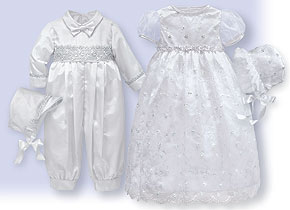|
Irish christening gowns stand
|
 |
| Heirloom Quality Irish Christening Sets Available @ Creative Irish Gifts |
Shingerleens are embellishments to the gown using Irish lace, embroidery, or ribbons.
The embroidery could be any one of several Irish symbols, such as the shamrock, the claddagh, or a Celtic cross.
Whether you are Irish, Scottish, Welsh or not you may very well feel a special affinity for Celtic art. If that is the case, you may want to ensure that your baby's christening gown is embellished with ancient Celtic symbols, such as knotwork or spirals.
Irish christening gowns can be distinctive in a number of ways. Whether they are made from Irish linen, embellished with shamrocks, or a special gown made from part of the mother's bridal gown...Irish christening gowns stand out as truly unique heirlooms.
The symbolism of an heirloom christening gown
Go FROM Irish Christening Gowns
TO Fantasy-Ireland's Christening Guide

Fantasy Ireland is created by
Deborah A. Felker
and is licensed under a
Creative Commons Attribution-ShareAlike 3.0 Unported License.
For permissions beyond the scope
of this license contact the author.




